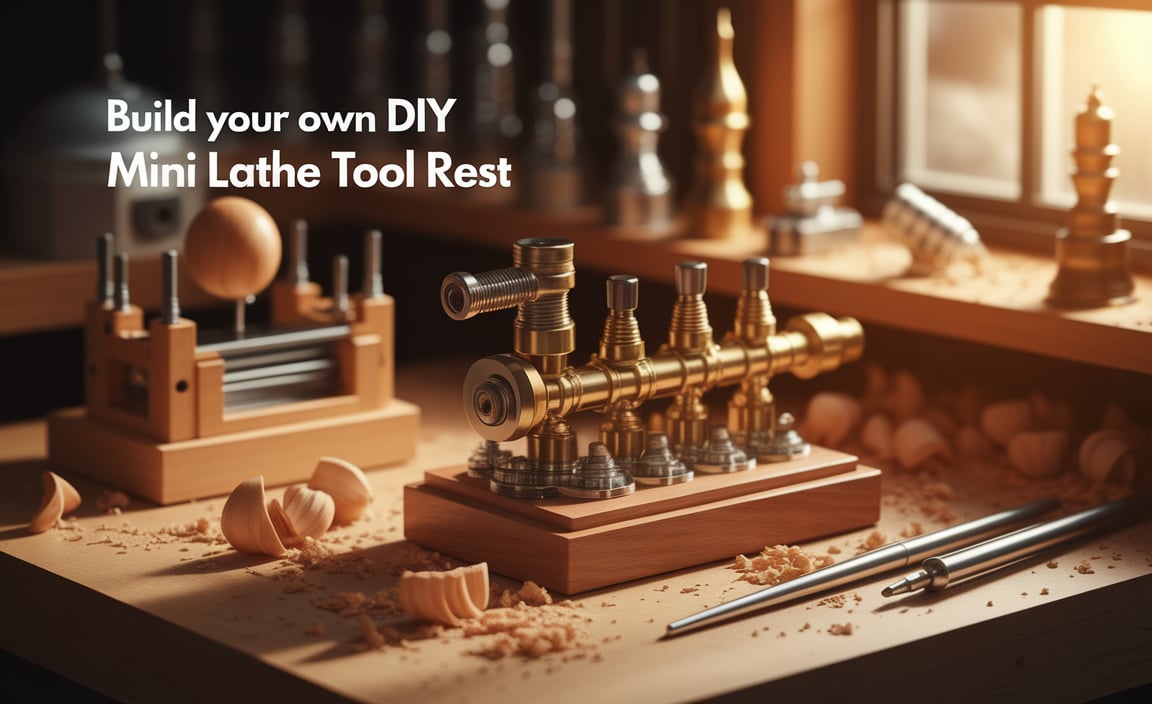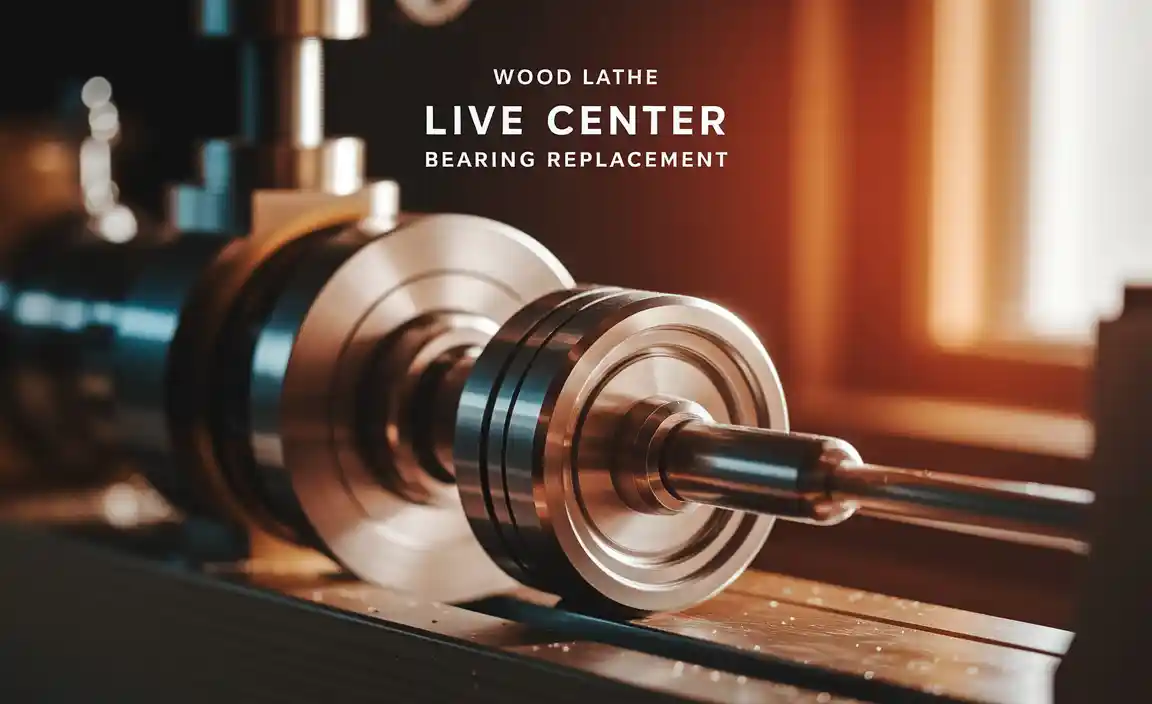Quick Summary: Achieve brilliant Delrin adaptive clearing with a 40-degree TiAlN ball nose end mill. This guide breaks down why this specific tool excels, how to set it up, and best practices for smooth, efficient machining, even for beginners.
Working with plastics like Delrin can be a bit tricky. You want clean cuts, no melting, and tools that last. Often, you might find yourself struggling with surface finish, tool wear, or chatter, especially when trying more advanced machining strategies like adaptive clearing. It can feel like you’re fighting the material instead of working with it. But don’t worry! We’ve got a fantastic solution that makes machining Delrin a breeze. In this guide, we’ll dive deep into using a 40-degree TiAlN ball nose end mill for adaptive clearing, transforming your Delrin projects from frustrating to fabulous.
Why a 40-Degree TiAlN Ball Nose End Mill for Delrin?
Let’s break down why this specific combination – a 40-degree helix angle, a ball nose shape, and a TiAlN coating – is a game-changer for machining Delrin, especially when using adaptive clearing strategies.
The Ball Nose Advantage
A ball nose end mill has a rounded tip. This shape is incredibly versatile. For adaptive clearing, where the toolpath removes material in continuous, high-speed movements, the rounded tip allows for:
- Smooth transitions: It can smoothly transition between different depths and widths, reducing stress on the tool and the workpiece.
- Contoured surfaces: Ideal for creating curved or complex shapes without needing multiple tool changes.
- Reduced stress points: Unlike a square-shouldered end mill with sharp corners, the ball nose has no acute angles, which can be a common failure point in harder materials.
The 40-Degree Helix Angle
The helix angle refers to the angle of the flutes around the cutting tool. A 40-degree angle offers a sweet spot for plastics like Delrin:
- Improved chip evacuation: A moderate helix angle helps efficiently clear chips away from the cutting zone. This is crucial for Delrin, which can otherwise melt and re-solidify onto the tool.
- Reduced cutting forces: It allows for a smoother, more gradual engagement with the material, leading to less chatter and a better surface finish.
- Good for general-purpose use: While steeper angles might be for softer materials and shallower for harder ones, 40 degrees is a solid all-rounder for many plastics.
TiAlN Coating: The Secret Weapon
TiAlN stands for Titanium Aluminum Nitride. This is a hard, wear-resistant coating applied to the end mill’s surface. For machining Delrin, TiAlN offers significant benefits:
- Heat resistance: Delrin, while a plastic, can generate heat during machining. TiAlN helps the tool withstand higher temperatures, preventing premature wear and the dreaded melting issue.
- Reduces friction: The coating creates a smoother surface, reducing the friction between the tool and the Delrin. This means less heat generated and a cleaner cut.
- Extended tool life: By protecting the cutting edge from heat and abrasion, TiAlN coatings dramatically increase how long your end mill will last, saving you money and downtime.
Understanding Adaptive Clearing
Adaptive clearing (sometimes called dynamic milling) is a modern machining strategy that’s fantastic for efficient material removal, especially in CAD/CAM software. Instead of traditional 2D pocketing, adaptive clearing uses a consistent tool engagement angle and a high-speed helical or trochoidal path. This means the tool is always cutting on a significant portion of its diameter, distributing the load evenly.
Here’s why it works so well with our chosen tool for Delrin:
- Constant Tool Load: By maintaining a consistent depth and width of cut, the tool experiences predictable forces. This makes it less likely to chip or break.
- High Efficiency: Tools can move faster and remove more material in less time compared to conventional methods.
- Preserves Tool Life: Because the load is distributed evenly, the cutting edges wear more uniformly, extending the useful life of the end mill.
- Excellent surface finish: The smooth, continuous cutting motion leads to a superior surface finish on the workpiece.
For Delrin, the advantages of adaptive clearing are amplified. The controlled material removal prevents the plastic from melting and gumming up the tool. The continuous motion, combined with the ball nose shape, ensures smooth, flowing cuts perfect for contoured parts.
Setting Up for Success: The Basics
Before you even think about hitting the “run” button, a little preparation goes a long way. Getting your setup right is key to safe and effective machining.
1. Choosing the Right End Mill
As we’ve discussed, look for:
- Type: Ball Nose
- Helix Angle: 40 degrees (or close to it, like 38-42 degrees)
- Coating: TiAlN (Titanium Aluminum Nitride)
- Material: Carbide is generally preferred for its hardness and ability to hold an edge.
- Number of Flutes: For plastics like Delrin, 2 or 3 flutes are often a good choice. More flutes can sometimes lead to chip packing in softer materials, while fewer can be forgiving. A 2-flute or 3-flute is a safe bet.
2. Workholding: Gripping Your Delrin
Securely holding your Delrin is paramount. You don’t want your workpiece shifting during a cut, especially with adaptive clearing.
- Vises: A good machinist’s vise is essential. Ensure the jaws are clean and provide a firm grip without crushing the Delrin. Plastic can deform under excessive pressure.
- Fixtures: For more complex or repeated operations, custom fixtures can be fabricated. These offer precise and secure holding.
- Doubled-Sided Tape/Tabs: For very light cuts or delicate parts, strong double-sided tape or small machining tabs can work, but always confirm they can withstand the cutting forces.
3. Tool Length and Runout
Ensure your end mill is held securely in your collet or tool holder. A tool holder that allows for good runout accuracy is important, as excessive runout can lead to an uneven cut and premature tool wear. Clamp the tool so it extends the necessary amount, but avoid excessive overhang, which can cause vibration. A good rule of thumb is to use the shortest possible tool length for the job to maintain rigidity. You can learn more about tool holders and collets from resources like Machinery Lubricants, which offers insights into their function.
4. Machine and Spindle Check
Before you start, ensure your milling machine is in good working order.
- Cleanliness: Make sure your spindle is clean and free of debris.
- Lubrication: Check that your machine’s lubrication system is functioning correctly.
- Tool Counterbalance (if applicable): If your machine has a tool counter-balance system, ensure it’s engaged and working properly.
Programming for Adaptive Clearing with a 40-Degree Ball Nose End Mill
This is where the magic happens! While you’ll likely use CAM software (like Fusion 360, Mastercam, SolidWorks CAM, etc.), understanding the parameters is key.
Key CAM Parameters to Consider:
When setting up your adaptive clearing operation, here are the crucial settings to pay attention to:
| Parameter | Explanation | Typical Settings for Delrin with 40-Degree Ball Nose |
|---|---|---|
| Tool Radius | Input the exact radius of your ball nose end mill (half its diameter). | (e.g., if you have a 6mm end mill, the radius is 3mm) |
| Stepover (Radial) | The distance the tool moves sideways in each pass. A smaller stepover provides a smoother finish but takes longer. | 20% – 50% of tool diameter. For a good balance of finish and speed, 30-40% is a common starting point. |
| Stepdown (Axial) | The depth the tool cuts into the material in each vertical pass. | 0.5mm – 2mm, or roughly 50% of tool diameter for very light cuts. For Delrin, you can often afford to go deeper than with metals, but avoid overwhelming the tool. Experiment to find the sweet spot. |
| Maximum Material in One Pass | A setting that limits the amount of material the cutter engages on the ‘cutting’ side of the tool. This is critical for adaptive clearing. | Often set to a percentage of the tool diameter (e.g., 20% – 40%). This ensures the tool doesn’t get overloaded. |
| Spindle Speed (RPM) | How fast the tool rotates. | Refer to manufacturer recommendations or a plastic machining chart. A good starting point for a 6mm carbide end mill in Delrin might be 10,000-20,000 RPM. |
| Feed Rate (IPM or mm/min) | How fast the tool moves through the material. This is directly related to spindle speed and chip load. | This requires calculation or experimentation. A good starting point might be 10-30 inches per minute (250-750 mm/min) for a 6mm end mill. Too fast = melting/chipping. Too slow = rubbing/heat. |
| Plunge Rate | How fast the tool drops vertically into the material. | Significantly slower than the feed rate, often 50% or less (e.g., 5-10 inches per minute or 125-250 mm/min). |
| Lead Angle / Ramp Angle | The angle at which the tool enters the material when not plunging vertically. Important for adaptive clearing. | Typically 5-10 degrees. This helps the tool engage gradually. |
It’s always a good idea to consult the end mill manufacturer’s data sheets for recommended cutting parameters. For example, companies like Kennametal provide valuable information on tool selection and usage.
Calculating Feed Rate: A Quick Guide
A fundamental concept in CNC machining is chip load, which is the thickness of material removed by each cutting edge per revolution. Maintaining an appropriate chip load prevents tool breakage, ensures good surface finish, and minimizes heat.
The formula is:
Feed Rate (IPM) = Spindle Speed (RPM) x Number of Flutes x Chip Load per Tooth (inches)
For metric:
Feed Rate (mm/min) = Spindle Speed (RPM) x Number of Flutes x Chip Load per Tooth (mm) x 1000
Example:
- End Mill: 6mm (0.236″) diameter, 2 flutes, TiAlN coated, 40-degree helix
- Spindle Speed: 15,000 RPM
- Target Chip Load per Tooth: 0.05 mm (This is a typical value for Delrin and similar plastics; always consult manufacturer data if available.)
Calculation:
Feed Rate = 15,000 RPM x 2 flutes x 0.05 mm/flute x 1000 = 1,500,000 mm/min (or 1500 m/min)
This is extremely fast and indicates that the chip load might be too high, or the RPM is too high for that chip load. This is where experimentation begins. You might reduce the chip load to 0.02mm, or reduce RPM. Let’s try again with a more conservative chip load:
Target Chip Load per Tooth: 0.02 mm
Feed Rate = 15,000 RPM x 2 flutes x 0.02 mm/flute x 1000 = 600,000 mm/min (or 600 m/min)
This is still very fast, highlighting that for plastics, higher RPMs and lower feed rates are common, but the calculation still points to the initial 0.05mm chip load being too aggressive. A typical feed rate for a 6mm end mill in Delrin might be around 500-800 mm/min at 15,000 RPM with 2 flutes. This means the actual chip load is much smaller, around 0.016 – 0.027mm. This is where experience or specific tooling data becomes vital. Start conservatively and adjust!
Machining Process: Step-by-Step
Now that we’ve covered the setup and programming, let’s walk through the actual machining process. Safety first, always!
- Perform a Dry Run: Before cutting any material, program your machine. Stand clear, disable spindle rotation, and jog your axes to simulate the toolpath. Watch the tool move through the air and ensure it follows the intended path without crashing into the workpiece or clamps. This is a critical safety step!
- Secure the Workpiece: Double-check that your Delrin block is clamped firmly and precisely. Ensure no part of the material can shift during machining.
- Install the End Mill: Carefully insert the 40-degree TiAlN ball nose end mill into the tool holder or collet and tighten securely. Ensure it’s seated correctly.
- Set Work Zero: Accurately set your machine’s X, Y, and Z zero points relative to your workpiece or fixture. For Z zero, usually, this is set on the top surface of your Delrin block.
- Start the Spindle and Feed: With the spindle at the programmed RPM, begin the cutting process. Engage the feed rate slowly and observe the initial cuts.
- Monitor the Cut: Listen to the sound of the machine. A smooth, consistent hum is good. Any chattering, grinding, or high-pitched squealing indicates a problem that needs immediate attention. Watch for chip evacuation; a nice, continuous chip is ideal. Avoid a dusty powder (too light a cut) or visible melting/smoke (too heavy, too slow, or dull tool).
- Handle Chip Evacuation: Use compressed air or coolant (if appropriate for Delrin – check its reactivity) to help blow chips away from the cutting zone. This is vital to prevent re-cutting chips and causing heat buildup.
- Observe Surface Finish: After the adaptive clearing pass, visually inspect the machined surface. It should be smooth and free of tool marks or melting.
- Inspect Tool Condition: Periodically check the end mill for signs of wear, chipping, or material buildup. The TiAlN coating should generally keep the cutting edges clean.
- Complete Operations: Continue with any subsequent machining operations, always prioritizing safety and good machining practices.
Troubleshooting Common Issues
Even with the best tools and setup, you might encounter hiccups. Here’s how to deal with them:
1. Melting or Gumming Up
Cause: Too much heat, too slow of a feed rate, or not enough chip removal.
Solution:
- Increase feed rate (carefully, while maintaining an appropriate chip load for the RPM).
- Increase spindle speed (if your machine allows and the tool is rated for it).
- Reduce depth of cut (stepdown).
- Improve chip evacuation with compressed air or a mist coolant.
- Ensure your tool is sharp.
2. Scratchy or Poor Surface Finish
Cause: Tool is dull, excessive vibration, incorrect stepover, or material buildup on the tool.
Solution:
- Use a sharp, new end mill.
- Reduce stepover percentage.
- Ensure rigid workholding and tool setup.
- Check for runout in








